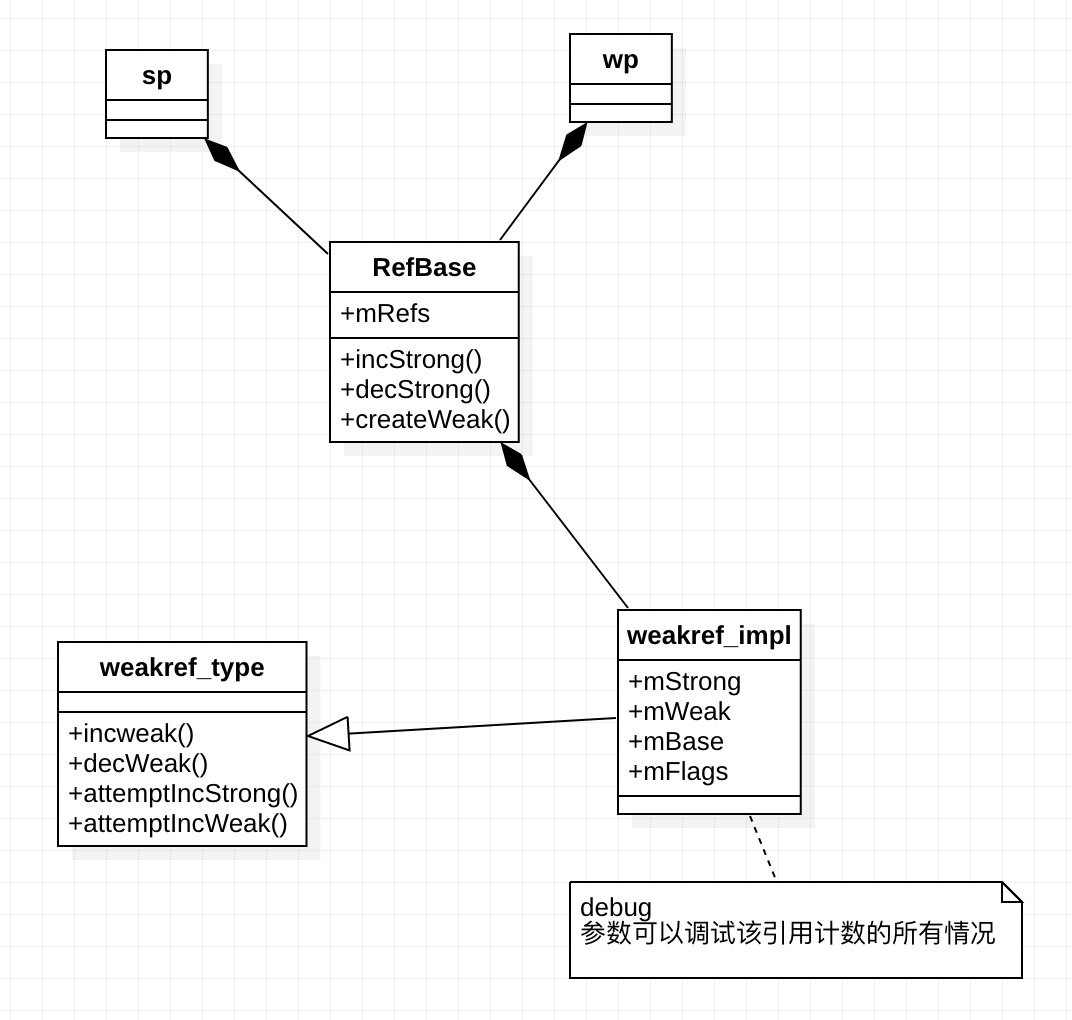目录
代码
class A:public RefBase
{
//A没有任何自己的功能
}
int main()
{
A* pA =new A;
...
}
这篇主要来讲述类的定义和创建该对象的时候,做了哪些事情。首先我们了解一下父类refbase.
RefBase
refbase的定义在system/core/libutils中,同时,我们看到DEBUG_REFS为0. 那么我们就可以先看非debug版本的refs。首先我们来看一下整体的定义。
class RefBase
{
public:
void incStrong(const void* id) const;
void decStrong(const void* id) const;
void forceIncStrong(const void* id) const;
//! DEBUGGING ONLY: Get current strong ref count.
int32_t getStrongCount() const;
class weakref_type
{
。。。 // 省略weakref_type的定义
};
weakref_type* createWeak(const void* id) const;
weakref_type* getWeakRefs() const;
//! DEBUGGING ONLY: Print references held on object.
inline void printRefs() const { getWeakRefs()->printRefs(); }
//! DEBUGGING ONLY: Enable tracking of object.
inline void trackMe(bool enable, bool retain)
{
getWeakRefs()->trackMe(enable, retain);
}
typedef RefBase basetype;
protected:
RefBase();
virtual ~RefBase();
//! Flags for extendObjectLifetime()
enum {
OBJECT_LIFETIME_STRONG = 0x0000,
OBJECT_LIFETIME_WEAK = 0x0001,
OBJECT_LIFETIME_MASK = 0x0001
};
void extendObjectLifetime(int32_t mode);
//! Flags for onIncStrongAttempted()
enum {
FIRST_INC_STRONG = 0x0001
};
// Invoked after creation of initial strong pointer/reference.
virtual void onFirstRef();
// Invoked when either the last strong reference goes away, or we need to undo
// the effect of an unnecessary onIncStrongAttempted.
virtual void onLastStrongRef(const void* id);
// Only called in OBJECT_LIFETIME_WEAK case. Returns true if OK to promote to
// strong reference. May have side effects if it returns true.
// The first flags argument is always FIRST_INC_STRONG.
// TODO: Remove initial flag argument.
virtual bool onIncStrongAttempted(uint32_t flags, const void* id);
// Invoked in the OBJECT_LIFETIME_WEAK case when the last reference of either
// kind goes away. Unused.
// TODO: Remove.
virtual void onLastWeakRef(const void* id);
private:
friend class weakref_type;
class weakref_impl;
RefBase(const RefBase& o);
RefBase& operator=(const RefBase& o);
private:
friend class ReferenceMover;
static void renameRefs(size_t n, const ReferenceRenamer& renamer);
static void renameRefId(weakref_type* ref,
const void* old_id, const void* new_id);
static void renameRefId(RefBase* ref,
const void* old_id, const void* new_id);
weakref_impl* const mRefs;
};
好,一开始代码肯定不可能完全记住,那我们就按照代码写的来,最后再补充细节。首先我们看如何创建的。
RefBase::RefBase()
: mRefs(new weakref_impl(this))
{
}
在创建的时候,会新建一个weakref_impl类型的变量赋值给mRefs,好的,那么我们看一下weakref_impl的定义。
class RefBase::weakref_impl : public RefBase::weakref_type
{
public:
std::atomic<int32_t> mStrong;
std::atomic<int32_t> mWeak;
RefBase* const mBase;
std::atomic<int32_t> mFlags;
//因为我们没开debug模式,所以先关注没debug模式的代码
explicit weakref_impl(RefBase* base)
: mStrong(INITIAL_STRONG_VALUE)
, mWeak(0)
, mBase(base)
, mFlags(0)
{
}
void addStrongRef(const void* /*id*/) { }
void removeStrongRef(const void* /*id*/) { }
void renameStrongRefId(const void* /*old_id*/, const void* /*new_id*/) { }
void addWeakRef(const void* /*id*/) { }
void removeWeakRef(const void* /*id*/) { }
void renameWeakRefId(const void* /*old_id*/, const void* /*new_id*/) { }
void printRefs() const { }
void trackMe(bool, bool) { }
};
好的,我们可以看到,这个impl集成自weakref_type,但是他真身还有strong,weak,以及flags的原子操作数。同时我们再看一下weakref_type
class weakref_type
{
public:
RefBase* refBase() const;
void incWeak(const void* id);
void decWeak(const void* id);
// acquires a strong reference if there is already one.
bool attemptIncStrong(const void* id);
// acquires a weak reference if there is already one.
// This is not always safe. see ProcessState.cpp and BpBinder.cpp
// for proper use.
bool attemptIncWeak(const void* id);
//! DEBUGGING ONLY: Get current weak ref count.
int32_t getWeakCount() const;
//! DEBUGGING ONLY: Print references held on object.
void printRefs() const;
//! DEBUGGING ONLY: Enable tracking for this object.
// enable -- enable/disable tracking
// retain -- when tracking is enable, if true, then we save a stack trace
// for each reference and dereference; when retain == false, we
// match up references and dereferences and keep only the
// outstanding ones.
void trackMe(bool enable, bool retain);
};
好,我们也看到了weakref_impl的定义。也就是定义了一些常用的方法。现在我们捋一下。class A创建的过程。首先,创建了一个type为weakrefs_impl的mrefs。这个refs中有strong,和weak的计数。同时,这个weakrefs_impl又是weakrefs_type,提供了方法来操作这些计数。那么我们就可以总结出来:在创建A的同时,我们创建了一个叫做mRefs的影子weakref_impl的影子对象。里面保存了计数,而且能够进行计数的增加和减少操作。
总结
虽然我们此处用的比较简单,因为我们例子就写的比较简单。但是还是有一些其他的成员是我们需要去记忆的。都在类图中了。总结下来就是,每一个需要只能指针的变量,都必须是refbase的子类。在创建该类的时候,会初始化一个类型为weakref_impl的影子变量mrefs用来记录强弱引用的指针。同时,sp和wp其实都是对mrefs也就是weakref_impl的操作。至于weakref_type是refbase的内部类,定义了影子对象的操作接口,而weakref_impl是对应的实现。实现了对应的影子对象操作接口。
